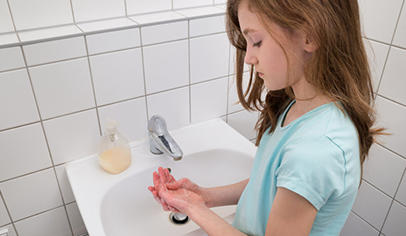Science Fair Investigation: Grades 3-5

Learning area: STEM
Time commitment: 45 minutes to 1 hour (plus time to conduct and present experiments)
Best for: Grade 3, Grade 4, Grade 5

Objective:
To introduce students to the process of planning and conducting a science fair project about germs and the spread of disease.
Materials:
- Science Fair Investigation Handout
- Other materials as needed for student projects
- Internet and library access for students
Education Standards:
- Health:
- 4.5.1 Demonstrate effective verbal and nonverbal communication skills to enhance health.
- 8.5.1 Express opinions and give accurate information about health issues.
- Science:
- A.1.a Ask questions about objects, organisms, and events in the environment.
- A.1.b Plan and conduct a simple investigation.
- A.1.e Communicate investigations and explanations.
Instructions:
- Have students read the Science Fair Investigation handout. Explain that they will follow the process outlined on the handout to design a science fair project related to germs and illness.
- Review with students what they already know about germs.
- As a class, brainstorm some questions students still have about germs.
- Ask each student to select two questions that really interest them and research topics related to those questions using online and library resources. If new questions arise during their research, students should be allowed to change their questions.
- Place students into small groups. If students are interested in the same topic, group them together, but it is not necessary for all groups to be organized around the same topic.
- Have students share their research questions with their small group and brainstorm ideas for experiments to answer the questions. Small groups will brainstorm ideas for several topics, depending on the variety of topics within the group.
- Have each student, working independently, select the research question they want to focus on for their project, and complete steps 5 through 11 on the handout to design their experiment.
- Meet with each student to discuss the experiment design before students begin conducting their experiments.
- As students conduct their experiments, remind them to repeat the experiment, if possible, to validate their results. Check in with each student periodically to review their data and head off any problems.
- Introduce examples or images of past science fair projects. Brainstorm different ways students might present their data at the science fair. Brainstorm ideas for additional information they might include in their display.
- For the science fair, display the boards around the room and invite parents or other classrooms to visit. Allow time for students to present their results to the attendees.
Interactive Whiteboard Extension
1. Have students create a PowerPoint presentation of their science fair project. they might include photographs of an experiment at different stages, charts, graphs, etc.
2. Have students present their presentation to the class using a whiteboard.
Find more resources at www.clorox.com/classrooms



